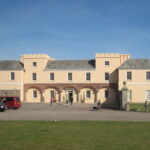.
Sir James Tillie (1647-1713)
Of Wingfield, Bradford on Avon, Wiltshire & Cornwall
.

On a plaque on the outside wall of the Parish Church of St Mary Wingfield
Erected Anno Dom: 1687
By Sr. JAMES TILLIE, Kt.
To the Memory of his Ancestors, who, in this Parish, lived Vertuously, & died Piously, and lie Interred under the Two Opposite Tombe Stones, (viz.) Under the nearest Stone John Tillie the Elder, and Mary his Wife, and Severall of their Children : And under the remotest Stone John Tillie the Younger, and Susanna his Wife, and Severall of their Children.
James Tillie was a colourful character.
His grandfather, John the Elder and father, John the Younger seem to have been yeoman farmers and gentlemen of Wingfield. He had at least one brother, Jeremiah, and a sister Mary; the plaque suggests there might have been others among the “Severall Children” of John and Susanna. Jeremiah was a cordwainer (leatherworker) in Bristol in 1673, but ten years later was styled as a merchant. In 1685 the Quakers of the Bristol Meeting referred to him as being of Port Royal, Jamaica and a probate inventory of his estate there in 1693 carried out after his death shows he was worth £6,032, including owning some slaves.
James turns up in London where, in 1673 he was admitted to the Middle Temple as a law student, although he may have been in London as early as 1668. On 14th of October 1680 James Tilley [sic], of Middle Temple married Margaret Vane (c1651-1682) at the church of Allhallows-on-the-Wall. She was the 5th daughter and 9th child of Sir Henry Vane the Younger (1613-1662), who was Governor of Massachusetts Colony in America 1636-1637, a Parliamentarian and colleague of Oliver Cromwell and was beheaded for treason at the Tower of London by King Charles II. His wife was Frances, daughter of Sir Christopher Wray MP (1601-1646), another Parliamentarian. However, Margaret died less than two years after the marriage, on 11th April 1682 and she was buried in the Vane family vault at Shipbourne, Kent.
He turns up in various land transactions, including the former copyhold of his father John and other land in Wingfield, Rowley, Westwood and Farleigh Hungerford in 1683 and 1684 and then in 1685 he acquired property at Padreda (now called Patrieta) in Linkinhorne, Cornwall.
On the 14th January 1686/7 he was made a Knight Batchelor by King James II at Whitehall Palace, although it is not known why. The King was deeply unpopular at the time and needed as many friends as he could get and equally as much money as possible and perhaps Tillie purchased the honour with cash. The King was expelled from England in the following year in what became known as The Glorious Revolution.
Now as Sir James Tillie Kt., he married again, on 27th November 1691, again at Allhallows-on-the Wall in the City of London, to Lady Elizabeth Coryton, daughter of Sir Richard Chiverton, who was Lord Mayor of London in 1657-8. She was also the widow of Sir John Coryton (1648-1690), a landowner at Newton Ferrers, near Plymouth in South Devon and St Mellion in Cornwall and MP for Callington, Devon in 1685 and 1679-80. Tillie had acted as witness to several documents for Sir John Coryton between 1668 and 1676 and in 1682.
Tillie was at pains to establish his standing by perhaps building up that of his family in Wingfield as yeomen farmers or minor gentry -hence the plaque on the church- and purchased land around their farm to form an estate and perhaps built a mansion, now mostly gone, at Belle Cour in Pomeroy Lane.
He also built a grand mansion on his new estate in Cornwall, which was called Pentillie Castle and where he lived for the rest of his life. His burial has become legendary, as he stipulated that his body be sat, dressed in his best clothes, in a chair in a folly/mausoleum building near the house; archaeologists found human remains there in 2013, possibly his.
With no chldren of his own, Sir James was succeeded by James (died in 1746), son of his sister Mary who had married William Woollie or Woolly, a Quaker merchant of Bristol. He assumed the surname of Tillie and was still holding land in Wingfield and Stowford in 1744 and left money for the poor of Wingfield in his will.



